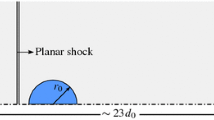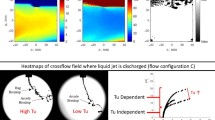Abstract
Waterjet breakup is traditionally considered to follow the Ohnesorge classification. In this classification, high Reynolds number waterjets are considered to atomize quickly after discharge. By generating a constricted waterjet where the water flow stays detached all the way through the nozzle, we have observed the first wind-induced breakup mode at high Reynolds numbers. Such a peculiar behavior, however, was not observed in non-constricted waterjets. Our results indicate that, constricted jets do not follow the Ohnesorge classification, in contrast to the non-constricted waterjets. We discuss the impact of nozzle geometry on the characteristics of waterjets and support our discussion by numerical simulations.










Similar content being viewed by others
Abbreviations
- Z :
-
Ohnesorge number
- μ L :
-
water dynamic viscosity
- σ :
-
air–water surface tension
- ρ L :
-
water density
- ρ g :
-
air density
- d j :
-
waterjet diameter at the nozzle outlet
- d 0 :
-
nozzle capillary diameter
- U L :
-
flow velocity
- We L :
-
Weber number based on water density
- We g :
-
Weber number based on air density
- Re L :
-
Reynolds number
References
Arai M, Shimizu M, Hiroyasu H (1988) Breakup length and spray formation mechanism of a high speed liquid jet. In: Proceedings of the International Conference of Liquid Atomization and Spray Systems (ICLASS-88), pp 177–184
Bayvel L, Orzechowski Z (1993) Liquid atomization. Taylor & Francis, London
Begenir A, Vahedi Tafreshi H, Pourdeyhimi B (2004) Effects of the nozzle geometry on hydroentangling waterjets: experimental study. Textile Res J (in press)
Bunnell RA, Heister SD (2000) Three-dimensional unsteady simulation of cavitating flows in injector passages. J Fluid Eng 122:791–797
Bunnell RA, Heister SD, Yen C, Collicott SH (1999) Cavitating injector flows: validation of numerical models and simulations of pressure atomizers. Atomiz Sprays 9:445–465
Chandrasekhar S (1961) The capillary instability of a liquid jet. In: Hydrodynamic and hydromagnetic stability. Oxford University Press, Oxford, pp 537–542
Chaves H, Knapp M, Kubitzek A, Obermeier F, Schneider T (1995) Experimental study of cavitation in the nozzle hole of diesel injectors using transparent nozzles. SAE papers, 1995-0290
Chigier N, Reitz RD (1996) Regimes of jet breakup and breakup mechanisms (physical aspects). In: Kuo KK (ed) Recent advances in spray combustion: spray atomization and drop burning phenomena, vol 1. AIAA, Reston, Va., pp 109–35
Ghassemieh E, Versteeg HK, Acar M (2003) Effect of nozzle geometry on the flow characteristics of hydroentangling jets. Textile Res J 73:444–450
Henry ME, Collicott SH (2000) Visualization of internal flow in a cavitating slot orifice. Atomiz Sprays 10: 545–563
Hiroyasu H (2000) Spray breakup mechanism from the hole-type nozzle and its applications. Atomiz Sprays 10:511–521
Hiroyasu H, Arai M, Shimizu M (1991) Breakup length of a liquid jet and internal flow in a nozzle. Proc. Proceedings of the International Conference of Liquid Atomization and Spray Systems (ICLASS), pp 123–133
Knapp RT, Daily JW, Hammitt FG (1970) Cavitation. McGraw-Hill, New York
Lefebvre AH (1989) Atomization and sprays. Hemisphere, Washington, DC
Lin SP, Reitz RD (1998) Drop and spray formation from a liquid jet. Ann Rev Fluid Mech 30:85–105:
Ohnesorge W (1936) Formation of drops by nozzles and the breakup of liquid jets. Z Angew Math Mech 16:355–358
Ohrn TR, Senser DW, Lefebvre H (1991) Geometrical effects on discharge coefficients for plain-orifice atomizers. Atomiz Sprays 1:137–153
Ong D, Yeh C-P, Hoverman TJ, Collicott SH (2003) Effects of a small step in an orifice on liquid jet breakup. Atomiz Sprays 13:297–307
Rayleigh Lord (1879a) On the capillary phenomenon of jets. Proc R Soc Lond 29:71–97
Rayleigh Lord (1879b) On the instability of jets. Proc Lond Math Soc 10:4–13
Reitz RD, Bracco FV (1986) Mechanisms of breakup of round liquid jets. In: Cheremisnoff N (ed) The encyclopedia of fluid mechanics, vol 3. Gulf Publishing, N.J., pp 233–249
Schmidt DP, Rutland CJ, Corradini ML, Roosen P, Genge O (1999) Cavitation in two dimensional asymmetric nozzles. SAE paper 1999-01-0518
Soteriou C, Andrews R, Smith M (1995) Direct injection diesel sprays and the effect of cavitation and hydraulic flip on atomization. SAE paper 950080, pp 27–51
Tamaki N, Shimizu M, Hiroyasu H (2001) Enhancement of the atomization of a liquid jet by cavitation in a nozzle hole. Atomiz Sprays 11:125–137
Tamaki N, Shimizu M, Nishida K, Hiroyasu H (1998) Effects of cavitation and internal flow on atomization of a liquid jet. Atomiz Sprays 8:179–197
Tseng K-T, Collicott SH (2003) Fluidic spray control. In: Proceedings of the 16th Annual Conference ILASS—Americas, Institute for Liquid Atomization and Spray Systems, Monterey, Calif., 18–21 May 2003
Vahedi Tafreshi H, Pourdeyhimi B (2004) Simulation of cavitation and hydraulic flip inside hydroentangling nozzles. Textile Res J (in press)
Vahedi Tafreshi H, Begenir A, Pourdeyhimi B (2003a) The role of nozzle design in characteristics of the hydroentangling waterjets. In: Proceedings of the 16th Annual Conference ILASS—Americas, Institute for Liquid Atomization and Spray Systems, Monterey, Calif., 18–21 May
Vahedi Tafreshi H, Pourdeyhimi B, Holmes R, Shiffler D (2003b) Simulation and characterization of water flow inside hydroentangling orifices. Textile Res J 73:256–262
Wu P-K, Miranda RF, Faeth GM (1995) Effects of initial flow conditions on primary breakup of non-turbulent and turbulent round liquid jets. Atomiz Sprays 5:175–196
Acknowledgement
The current work is supported by the Nonwovens Cooperative Research Center. Their support is gratefully acknowledged.
Author information
Authors and Affiliations
Corresponding author
Rights and permissions
About this article
Cite this article
Vahedi Tafreshi, H., Pourdeyhimi, B. The effects of nozzle geometry on waterjet breakup at high Reynolds numbers. Exp Fluids 35, 364–371 (2003). https://doi.org/10.1007/s00348-003-0685-y
Received:
Accepted:
Published:
Issue Date:
DOI: https://doi.org/10.1007/s00348-003-0685-y




